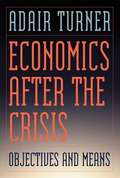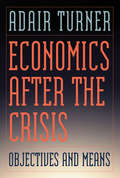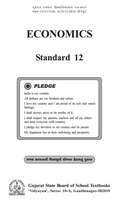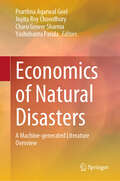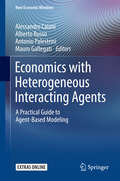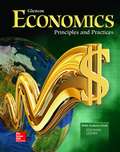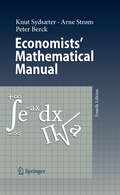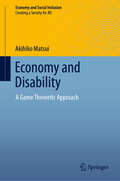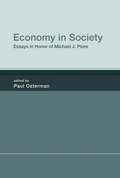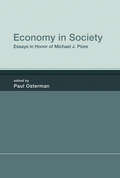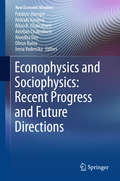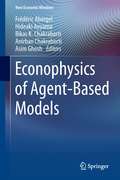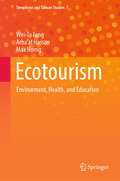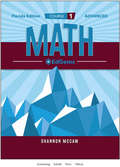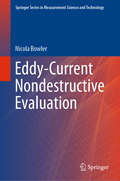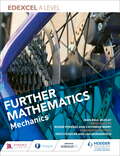- Table View
- List View
Economics After the Crisis
by Adair TurnerThe global economic crisis of 2008--2009 seemed a crisis not just of economic performance but also of the system's underlying political ideology and economic theory. But a second Great Depression was averted, and the radical shift to New Deal-like economic policies predicted by some never took place. Perhaps the correct response to the crisis is simply careful management of the macroeconomic challenges as we recover, combined with reform of financial regulation to prevent a recurrence. In Economics After the Crisis, Adair Turner offers a strong counterargument to this somewhat complacent view. The crisis of 2008--2009, he writes, should prompt a wide set of challenges to economic and political assumptions and to economic theory. Turner argues that the faults of theory and policy that led to the crisis were integral elements within a broader set of simplistic beliefs about the objectives and means of economic activity that dominated policy thinking for several decades. This dominant discourse cast economic growth as the objective, markets as the universally applicable means of achieving it, and inequality as inevitable and necessary. Turner takes on these assumptions point by point, arguing that more rapid growth should not be the overriding objective for rich developed countries, that inequality should concern us, that the pre-crisis confidence in financial markets as the means of pursuing objectives was profoundly misplaced, and that these conclusions have broad implications for the case for economic freedom, for specific areas of public policy (including financial regulation and climate change), and for the discipline of economics itself.
Economics After the Crisis: Objectives and Means (Lionel Robbins Lectures)
by Adair TurnerA noted economist challenges the fundamental economic assumptions that cast economic growth as the objective and markets as the universally applicable means of achieving it. The global economic crisis of 2008–2009 seemed a crisis not just of economic performance but also of the system's underlying political ideology and economic theory. But a second Great Depression was averted, and the radical shift to New Deal-like economic policies predicted by some never took place. Perhaps the correct response to the crisis is simply careful management of the macroeconomic challenges as we recover, combined with reform of financial regulation to prevent a recurrence. In Economics After the Crisis, Adair Turner offers a strong counterargument to this somewhat complacent view. The crisis of 2008–2009, he writes, should prompt a wide set of challenges to economic and political assumptions and to economic theory. Turner argues that more rapid growth should not be the overriding objective for rich developed countries, that inequality should concern us, that the pre-crisis confidence in financial markets as the means of pursuing objectives was profoundly misplaced.
Economics class 12 - GSTB
by Gujarat State Board of School TextbooksThe Gujarat State Board of School Textbooks takes pleasure in presenting this textbook to the students. It is prepared according to the new syllabus of Economics for Standard 12. This textbook is written and reviewed by expert teachers and professors. This textbook is published after incorporating the necessary changes suggested by the reviewers.
Economics of Natural Disasters: A Machine-generated Literature Overview
by Prarthna Agarwal Goel Joyita Roy Chowdhury Charu Grover Sharma Yashobanta ParidaThis book is a machine-generated literature overview that explores the theoretical and empirical aspects of economics of natural disasters such as floods, cyclones, droughts, and earthquakes from a policy perspective. It provides a comprehensive collection of economic theories in Disasters and empirical findings that would benefit scholars in academia and policy-making. On the theory side, there is a growing use of game theory, Input-Output, computable general equilibrium models, and Catastrophe models to analyze the economic impacts of natural disasters. These models provide optimal decisions for the government concerning disaster relief. On the empirical front, studies showing causal and associative relationships between disasters and socio-economic variables are important for estimating disaster-related losses and making appropriate policy suggestions.The book explores different critical aspects and interlinkages of natural disasters; economic, social, and political. Besides having localized effects, disasters influence macroeconomic parameters, such as impacts on international trade and foreign direct investment. Moreover, the effects of disasters are subject to interventions from various national and international agencies. It discusses fiscal pressures caused due to disasters and existing policies related to disaster-risk mitigation and management as a guide to policy-making. It is an important guide to researchers and policymakers examining the socio-economic impact of natural disasters and public investment for disaster-risk mitigation.
Economics of Tourism in Portugal: Impacts of the COVID-19 Pandemic (SpringerBriefs in Economics)
by Vítor João MartinhoThis Brief discusses impacts of the COVID-19 pandemic on the Portuguese tourism sector. Taking into account real-world conditions and the importance of the tourism sector for the Portuguese economy, this book highlights the economic contexts of tourism in Portugal at the regional and municipal levels, discussing pre-pandemic economic frameworks and projecting potential implications for the future. Using data provided by Statistics Portugal, the Brief performs econometric analysis on three cases: new paradigms for overnight stays and guests, changes in tourism revenues and prospective alternatives, and a comparison of effects on changes in number of guests and overnight stays at the regional level. Providing cutting edge analysis of a dynamic global situation, this Brief will be useful for researchers interested in tourism economics and European economics as well as policymakers and industry professionals.
Economics with Heterogeneous Interacting Agents
by Mauro Gallegati Alessandro Caiani Alberto Russo Antonio PalestriniThis book offers a practical guide to Agent Based economic modeling, adopting a learning by doing approach to help the reader master the fundamental tools needed to create and analyze Agent Based models. After providing them with a basic toolkit for Agent Based modeling, it present and discusses didactic models of real financial and economic systems in detail. While stressing the main features and advantages of the bottom-up perspective inherent to this approach, the book also highlights the logic and practical steps that characterize the model building procedure. A detailed description of the underlying codes, developed using R and C, is also provided. In addition, each didactic model is accompanied by exercises and applications designed to promote active learning on the part of the reader. Following the same approach, the book also presents several complementary tools required for the analysis and validation of the models, such as sensitivity experiments, calibration exercises, economic network and statistical distributions analysis. By the end of the book, the reader will have gained a deeper understanding of the Agent Based methodology and be prepared to use the fundamental techniques required to start developing their own economic models. Accordingly, Economics with Heterogeneous Interacting Agents will be of particular interest to graduate and postgraduate students, as well as to academic institutions and lecturers interested in including an overview of the AB approach to economic modeling in their courses. "
Economics: Principles And Practices
by McGraw-Hill EducationProven in the classroom, Economics: Principles and Practices provides a solid basis for learning economics for all students based on the twenty standards from the Council of Economic Education Includes Print Student Edition
Economists' Mathematical Manual
by Knut Sydsaeter Peter Berck Arne StrømThis volume presents mathematical formulas and theorems commonly used in economics. It includes both formulas like Roy`s identity that are peculiar to economics and formulas like Leibniz's rule that are common to many areas of applied mathematics. The volume is meant to be a reference work, to be used by students in conjunction with a textbook and by researchers in need of exact statements of mathematical results. The volume is the first grouping of this material for a specifically economist audience.
Economy and Disability: A Game Theoretic Approach (Economy and Social Inclusion)
by Akihiko MatsuiSociety has developed so that it accommodates the needs of intertwined people, but a question arises as to which people have been accommodated. Has everyone been taken care of in an equal manner? If not, who has fallen into the gap between the institutions that are supposed to accommodate them? This book is a study of these issues of economy and disability using game theory, which has provided a means of analyzing various social phenomena. Part I provides actual cases related to economy and disability, with the stories based on interviews by the author. Part II is geared toward a game theoretic analysis. This book explains disability-related issues by game theory and innovates that theory by deeply contemplating the issues.It is not common that first-rate theorists manage to make their research relevant and applicable to the most pressing problems our society faces these days. This is the remarkable achievement of this book. Akihiko Matsui, an internationally recognized leader in economic theory, succeeds in bringing profound game theoretical insights to the questions of disability, the social norms relating to it, and the ethical and economic problems they raise. The book is a tour de force, brilliantly combining economic and sociology, mathematics and philosophy, to provide us a fresh look at the way we run modern societies.Itzahk Gilboa, Professor, Eitan Berglas School of Economics, Tel-Aviv University and Professor of Economics and Decision Sciences, HEC, ParisThe present world faces a broad range of societal problems such as discrimination against minorities and conflicts between groups. The market mechanism may solve some of these dilemmas, but many others remain. This book targets various societal problems and provides game theoretical approaches to them, stressing the importance of social institutions including the market system and individual interactive attitudes to society. Aki Matsui’s splendid Economy and Disability is indispensable for students and scholars interested in social science, particularly in economic theory, and gives a better understanding of these phenomena and their potential cures.Mamoru Kaneko, Professor, Faculty of Political Science and Economics, Waseda UniversityIn this book, Aki Matsui is revealed to be a fully-fledged humanist in the guise of a game theoretician. He beautifully presents game-theoretical ideas while at the same time suggesting how society should relate to the disabled. This unique combination makes Economy and Disability—apart from anything else—a truly moving book.Ariel Rubinstein, Professor of Economics, Eitan Berglas School of Economics, Tel-Aviv University and Professor of Economics, New York University
Economy in Society
by Paul OstermanIn Economy in Society, five prominent social scientists honor Michael J. Piore in original essays that explore key topics in Piore's work and make significant independent contributions in their own right. Piore is distinctive for his original research that explores the interaction of social, political, and economic considerations in the labor market and in the economic development of nations and regions. The essays in this volume reflect this rigorous interdisciplinary approach to important social and economic questions.M. Diane Burton's essay extends our understanding of internal labor markets by considering the influence of surrounding firms; Natasha Iskander builds on Piore's theory of immigration with a study of Mexican construction workers in two cities; Suzanne Berger highlights insights from Piore's work on technology and industrial development; Andrew Schrank takes up the theme of regulatory discretion; and Charles Sabel discusses theories of public bureaucracy.
Economy in Society: Essays in Honor of Michael J. Piore
by edited by Paul OstermanProminent economists discuss internal labor markets, the dynamics of immigration, labor market regulation, and other key topics in the work of Michael J. Piore. In Economy in Society, five prominent social scientists honor Michael J. Piore in original essays that explore key topics in Piore's work and make significant independent contributions in their own right. Piore is distinctive for his original research that explores the interaction of social, political, and economic considerations in the labor market and in the economic development of nations and regions. The essays in this volume reflect this rigorous interdisciplinary approach to important social and economic questions.M. Diane Burton's essay extends our understanding of internal labor markets by considering the influence of surrounding firms; Natasha Iskander builds on Piore's theory of immigration with a study of Mexican construction workers in two cities; Suzanne Berger highlights insights from Piore's work on technology and industrial development; Andrew Schrank takes up the theme of regulatory discretion; and Charles Sabel discusses theories of public bureaucracy.
Econophysics Approaches to Large-Scale Business Data and Financial Crisis: Proceedings of Tokyo Tech-Hitotsubashi Interdisciplinary Conference + APFA7
by Tsutomu Watanabe Hideki Takayasu Misako TakayasuThe new science of econophysics has arisen out of the information age. As large-scale economic data are being increasingly generated by industries and enterprises worldwide, researchers from fields such as physics, mathematics, and information sciences are becoming involved. The vast number of transactions taking place, both in the financial markets and in the retail sector, is usually studied by economists and management and now by econophysicists. Using cutting-edge tools of computational analysis while searching for regularities and "laws" such as those found in the natural sciences, econophysicists have come up with intriguing results. The ultimate aim is to establish fundamental data collection and analysis techniques that embrace the expertise of a variety of academic disciplines. This book comprises selected papers from the international conference on novel analytical approaches to economic data held in Tokyo in March 2009. The papers include detailed reports on the market behavior during the financial crisis of 2008 and discussions on the mechanism of bubbles and crashes, with proposals for avoiding new crises. Filled with up-to-date research, this book will interest researchers and students, finance professionals, and scholars in diverse fields.
Econophysics and Companies: Statistical Life and Death in Complex Business Networks
by Hideaki Aoyama Yoshi Fujiwara Yuichi Ikeda Hiroshi Iyetomi Wataru SoumaEconophysics is an emerging interdisciplinary field that takes advantage of the concepts and methods of statistical physics to analyse economic phenomena. This book expands the explanatory scope of econophysics to the real economy by using methods from statistical physics to analyse the success and failure of companies. Using large data sets of companies and income-earners in Japan and Europe, a distinguished team of researchers show how these methods allow us to analyse companies, from huge corporations to small firms, as heterogeneous agents interacting at multiple layers of complex networks. They then show how successful this approach is in explaining a wide range of recent findings relating to the dynamics of companies. With mathematics kept to a minimum, the book is not only a lively introduction to the field of econophysics but also provides fresh insights into company behaviour.
Econophysics and Sociophysics: Recent Progress and Future Directions
by Bikas K. Chakrabarti Anirban Chakraborti Hideaki Aoyama Frédéric Abergel Dhruv Raina Nivedita Deo Irena VodenskaThis book presents the proceedings from ECONOPHYS-2015,an international workshop held in New Delhi, India, on the interrelated fieldsof "econophysics" and "sociophysics", which have emerged from the applicationof statistical physics to economics and sociology. Leading researchers fromvaried communities, including economists, sociologists, financial analysts,mathematicians, physicists, statisticians, and others, report on their recentwork, discuss topical issues, and review the relevant contemporary literature. A society can be described as a group of peoplewho inhabit the same geographical or social territory and are mutually involvedthrough their shared participation in different aspects of life. It is possibleto observe and characterize average behaviors of members of a society, an examplebeing voting behavior. Moreover, the dynamic nature of interaction within anyeconomic sector comprising numerous cooperatively interacting agents has manyfeatures in common with the interacting systems of statistical physics. It ison these bases that interest has grown in the application within sociology andeconomics of the tools of statistical mechanics. This book will be of value forall with an interest in this flourishing field.
Econophysics of Agent-based models
by Bikas K. Chakrabarti Anirban Chakraborti Hideaki Aoyama Frédéric Abergel Asim GhoshThe primary goal of this book is to present the research findings and conclusions of physicists, economists, mathematicians and financial engineers working in the field of "Econophysics" who have undertaken agent-based modelling, comparison with empirical studies and related investigations. Most standard economic models assume the existence of the representative agent, who is "perfectly rational" and applies the utility maximization principle when taking action. One reason for this is the desire to keep models mathematically tractable: no tools are available to economists for solving non-linear models of heterogeneous adaptive agents without explicit optimization. In contrast, multi-agent models, which originated from statistical physics considerations, allow us to go beyond the prototype theories of traditional economics involving the representative agent. This book is based on the Econophys-Kolkata VII Workshop, at which many such modelling efforts were presented. In the book, leading researchers in their fields report on their latest work, consider recent developments and review the contemporary literature.
Econophysics of Income and Wealth Distributions
by Bikas K. Chakrabarti Anirban Chakraborti Satya R. Chakravarty Arnab ChatterjeeThe distribution of wealth and income is never uniform, and philosophers and economists have tried for years to understand the reasons and formulate remedies for such inequalities. This book introduces the elegant and intriguing kinetic exchange models that physicists have developed to tackle these issues. This is the first monograph in econophysics focussed on the analyses and modelling of these distributions, and is ideal for physicists and economists. It is written in simple, lucid language, with plenty of illustrations and in-depth analyses, making it suitable for researchers new to this field as well as specialized readers. It explores the origin of economic inequality and examines the scientific steps that can be taken to reduce this inequality in the future.
Ecotourism: Environment, Health, and Education (Sinophone and Taiwan Studies #7)
by Wei-Ta Fang Arba'at Hassan Max HorngThis book bridges the gap on the critical issues of ecotourism and direct economic assistance to the conservation of local ecological and human resources. It covers various topics and case studies by ecotourism destination and ecotourism route from Sinophone and Taiwanese perspectives. Each chapter of this book includes comprehensive proposes as an important core value for planning and operating ecotourism. According to Sustainable Development Goals (SDGs), this book highlights our balanced understanding of sustainable tourism from the perspective of human ecology. Ecotourism needs to integrate the perspectives of population biology, bioanthropology, biomedicine, and public health and strengthen the connection between human ecology and disease. It is here to provide a comprehensive guide to all fascinating places for ecotourism courses. We encourage the following persons to read relevant chapters: (1) ecotourism entrepreneurs: business operators such as homestays, hot springs, ecological farms, and travel agencies; (2) ecotourism researchers: scholars and experts, university (specialized) college students, primary and secondary school teachers, and other ecotourism, environmental education, resource conservation, tourism and dining, leisure and recreation, other related fields researchers; and (3) ecotourism practice management and planners.
EdGems Core Math, Course 1
by Beth Armstrong Shannon McCaw Sarah Schuhl Michelle Terry Scott ValwayNIMAC-sourced textbook
EdGems Math, Course 1, Advanced
by Beth Armstrong Shannon McCaw Sarah Schuhl Michelle Terry Scott ValwayNIMAC-sourced textbook
Eddy-Current Nondestructive Evaluation (Springer Series in Measurement Science and Technology)
by Nicola BowlerThis book covers the topic of eddy current nondestructive evaluation, the most commonly practiced method of electromagnetic nondestructive evaluation (NDE). It emphasizes a clear presentation of the concepts, laws and relationships of electricity and magnetism upon which eddy current inspection methods are founded. The chapters include material on signals obtained using many common eddy current probe types in various testing environments. Introductory mathematical and physical concepts in electromagnetism are introduced in sufficient detail and summarized in the Appendices for easy reference. Worked examples and simple calculations that can be done by hand are distributed throughout the text. These and more complex end-of-chapter examples and assignments are designed to impart a working knowledge of the connection between electromagnetic theory and the practical measurements described. The book is intended to equip readers with sufficient knowledge to optimize routine eddy current NDE inspections, or design new ones. It is useful for graduate engineers and scientists seeking a deeper understanding of electromagnetic methods of NDE than can be found in a guide for practitioners.
Edexcel A Level Further Mathematics Mechanics
by Jean-Paul MuscatProvide full support for the Further Mechanics options with worked examples, stimulating activities and assessment support developed by subject experts and in conjunction with MEI (Mathematics in Education and Industry).The content benefits from the expertise of subject specialist Keith Pledger and the support of MEI (Mathematics in Education and Industry).- Ensure targeted development of reasoning and problem-solving skills with plenty of practice questions and structured exercises that improve mathematical skills and techniques.- Build connections between topics, using real-world contexts to help develop modelling skills, thus providing a fuller and more coherent understanding of mathematical concepts.- Overcome misconceptions and develop insight into problem solving with annotated worked examples.- Measure progress with graduated exercises that support you at every stage of your learning.
